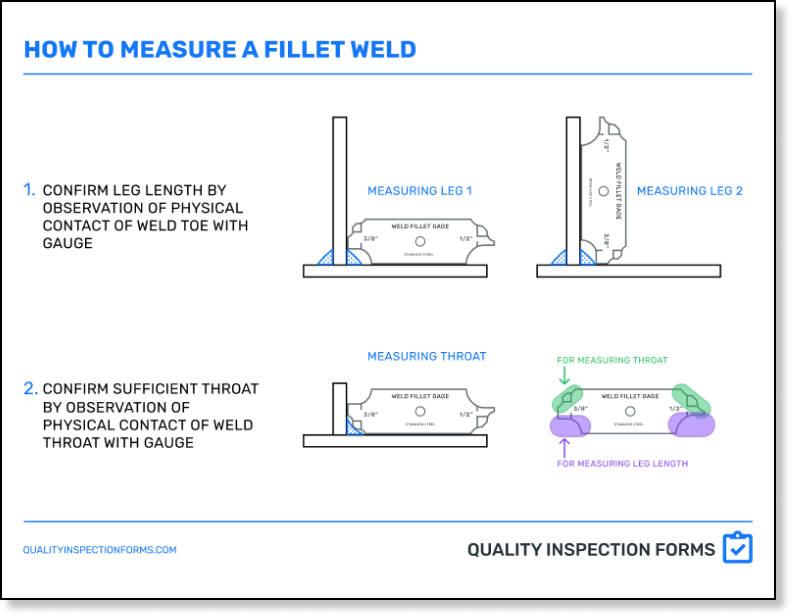How to Accomplish Precision with Gauge Fillet Welds in Your Jobs
How to Accomplish Precision with Gauge Fillet Welds in Your Jobs
Blog Article
Innovative Approaches to Fillet Weld Assessment and Testing: Enhancing Weld Quality and Conformity Specifications
In the realm of welding, the top quality and honesty of fillet welds play an important duty in making certain the structural stability and reliability of different commercial parts. With the constant drive for boosted effectiveness and compliance with stringent requirements, the expedition of cutting-edge methods to fillet weld evaluation and testing has come to be crucial.
Advanced Non-Destructive Testing Techniques
Utilizing modern modern technologies, advanced non-destructive testing methods play a crucial role in ensuring the stability and high quality of fillet welds. These techniques, such as phased selection ultrasonic testing (PAUT) and magnetic fragment testing (MPT), deal detailed understandings into the weld's inner framework without creating any type of damages to the product. PAUT, as an example, utilizes numerous ultrasonic elements to inspect the weld from different angles, giving a thorough visualization of prospective flaws like lack of combination or splits.
Similarly, MPT is efficient in finding surface-breaking flaws by applying a magnetic area and iron bits to the weld area. This technique is specifically useful for determining gaps that might jeopardize the weld's strength. By using these sophisticated non-destructive testing strategies, weld examiners can properly examine the quality of fillet welds, ensuring conformity with sector requirements and policies. The capacity to discover imperfections early not only boosts weld quality yet additionally protects against expensive rework or failings in architectural honesty, underlining the relevance of these cutting-edge testing methods in welding examinations.
Robotics and Automation in Inspection

The assimilation of robotics and automation has revolutionized the inspection procedure for fillet welds, improving efficiency and accuracy in high quality analysis. Robotics provide specific control and repeatability in evaluating welds, guaranteeing regular and trustworthy results. Automated systems can be configured to comply with specific evaluation courses, guaranteeing detailed insurance coverage of welds and minimizing the threat of human mistake.
Robotic examination systems outfitted with innovative sensors can spot and determine weld attributes with high precision, supplying detailed information for evaluation. These systems can determine problems such as splits, absence of fusion, and porosity, making it possible for prompt corrective actions to be taken. In addition, robotics and automation permit for real-time information collection and evaluation, offering prompt feedback to operators and helping with quick decision-making processes.
Furthermore, making use of robotics and automation in fillet weld evaluation improves general performance by decreasing examination times and raising inspection throughput. By streamlining the examination procedure, makers can ensure weld top quality and conformity requirements are met efficiently, eventually bring about set you back financial savings and enhanced product quality.
Using Expert System for Analysis
Synthetic intelligence plays a critical function in enhancing the efficiency and accuracy of evaluation in fillet weld inspection procedures. By using the power of AI, examiners can improve the analysis of weld quality and conformity standards, leading to more trustworthy and accurate outcomes. AI formulas can rapidly process vast quantities of data from weld assessments, discovering problems or variances that may be testing to relate to the nude eye. This sophisticated modern technology makes it possible for real-time tracking of weld top quality, enabling instant restorative activities to be taken if any type of problems are found.
Moreover, AI systems can pick up from past assessment data, consistently boosting their capacity to identify potential issues and discrepancies in fillet welds. This adaptive knowing capability enhances the general quality assurance process, lowering the likelihood of human company website error and making sure that recommended you read welds meet the called for requirements. By incorporating artificial intelligence right into fillet weld evaluation, industries can accomplish higher degrees of efficiency, consistency, and compliance in their evaluation methods.
Portable Equipment for On-Site Inspection
Enhancing area examination effectiveness, the fostering of portable tools changes on-site analysis procedures for fillet welds. These devices offer adaptability and comfort, permitting inspectors to carry out thorough examinations in different places, consisting of remote or difficult environments. Portable tools such as ultrasonic testing devices, magnetic fragment inspection tools, and digital radiography systems give real-time information and high-resolution imaging capacities, making it possible for quick decision-making and prompt responses on weld top quality.
One significant advantage of mobile tools is their ability to simplify inspection procedures, minimizing downtime and boosting general efficiency - Gauge Fillet Weld. Inspectors can quickly carry these tools to different job sites, getting rid of the demand for carrying heavy machinery or elements to off-site facilities. Furthermore, the mobility of these devices advertises cost-effectiveness by minimizing transportation expenses and speeding up examination timelines
Moreover, using mobile tools for on-site inspection advertises positive quality control steps, as assessors can quickly recognize and attend to any type of prospective welding issues or disparities. By incorporating these innovative modern technologies into on-site evaluation techniques, welding specialists can make sure compliance with industry criteria and improve weld top quality, ultimately bring about boosted architectural stability and security in various welding applications.
Combination of Information Administration Systems

Having actually enhanced on-site examination procedures via the utilization of portable devices, the next phase entails the smooth combination of information monitoring systems to further enhance effectiveness and information evaluation capacities in fillet weld examination and testing. By integrating data monitoring systems right into the examination procedure, companies can streamline data collection, storage, and analysis. This combination permits real-time monitoring of weld quality, instant recognition of problems, and punctual decision-making to fix any kind of concerns that may emerge throughout the evaluation procedure.
Information monitoring systems play an essential duty in systematizing assessment information, assisting in very easy access for licensed personnel, Go Here and ensuring information honesty and safety. With the integration of these systems, examiners can create extensive records, track historic information for trend analysis, and boost overall procedure effectiveness. Furthermore, the integration of information management systems makes it possible for seamless communication in between different stakeholders entailed in the inspection process, cultivating cooperation and boosting total quality assurance measures. Inevitably, the assimilation of data administration systems serves to elevate the standards of fillet weld examination and testing, ensuring conformity with market guidelines and improving weld high quality.
Conclusion
To conclude, ingenious techniques to fillet weld evaluation and screening have actually dramatically boosted weld top quality and compliance standards. Advanced non-destructive screening approaches, robotics, automation, expert system, portable devices, and data administration systems have actually changed the method weld assessments are performed. By making use of these modern technologies, sectors can make certain that welds meet the needed top quality criteria and guidelines, inevitably enhancing total efficiency and safety and security in welding procedures.

Having enhanced on-site inspection procedures via the use of mobile devices, the following stage entails the seamless integration of data management systems to better enhance effectiveness and data analysis capabilities in fillet weld examination and testing. Inevitably, the integration of data administration systems serves to elevate the requirements of fillet weld inspection and screening, ensuring compliance with industry policies and boosting weld high quality.

Report this page